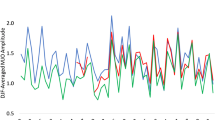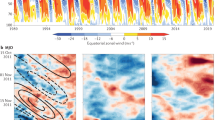Abstract
Observational evidence of the 11-year solar cycle (SC) modulation of stratosphere temperatures and winds from the ERA-40 dataset is reviewed, with emphasis on the Northern winter hemisphere. A frequency modulation of sudden warming events is noted, with warmings occurring earlier in solar minimum periods than in solar maximum periods. The observed interaction between the influence of the SC and the quasi biennial oscillation (QBO) on the frequency of sudden warmings is noted as a possible clue for understanding their mechanism of influence. A possible transfer route for the 11-year solar cycle from the equatorial stratopause region to the lowest part of the stratosphere is proposed, via an influence on sudden warming events and the associated induced meridional circulation. SC and QBO composites of zonal wind anomalies show anomalous wind distributions in the subtropical upper stratosphere in early winter. Mechanistic model experiments are reviewed that demonstrate a sensitivity of sudden warmings to small wind anomalies in this region. Various diagnostics from these experiments are shown, including EP fluxes and their divergence and also the synoptic evolution of the polar vortex, in order to understand the mechanism of the influence. Some recent GCM experiments to investigate the SC/QBO interaction are also described. They simulate reasonably well the observed SC/QBO interaction of sudden warming events and appear to support the hypothesis that tropical/subtropical upper stratospheric wind anomalies are an important influence on the timing of sudden warmings.
Similar content being viewed by others
References
Balachandran, N. K., and Rind, D.: 1995, ‘Modeling the effects of UV variability and the QBO on the troposphere stratosphere system. I: The middle atmosphere’, J. Clim. 8, 2058–2079.
Baldwin, M. P., and Gray, L. J.: 2005, ‘Tropical stratospheric zonal winds in ECMWF, ERA-40 reanalysis, rocketsonde data, and rawinsonde data’, Geophys. Res. Letts. 32, doi:10.1029/2004GL022328.
Baldwin, M. P., et al.: 2001, ‘The quasi biennial oscillation’, Rev. Geophys. 39, 179–229.
Cordero, E. C., and Nathan, T. R.: 2005, ‘A new pathway for communicating the 11-year solar cycle signal to the QBO’, Geophys. Res. Letts. 32, doi:10.1029/2005GL023696.
Crooks, S., and Gray, L. J.: 2005, ‘Characterisation of the 11-year solar signal using a multiple regression analysis of the ERA-40 dataset’, J. Clim. 18,7, 996–1015.
Gray, L. J.: 2003, ‘The influence of the equatorial upper stratosphere on stratospheric sudden warmings’, Geophys. Res. Lett. 30, doi:10.1029/2002GL016430.
Gray, L. J., Phipps, S. J., Dunkerton, T. J., Baldwin, M. P., Drysdale, E. F., and Allen, M. R.: 2001a, ‘A data study of the influence of the equatorial upper stratosphere on northern hemisphere stratospheric sudden warmings’, Q. J. R. Meteorol. Soc. 127, 1985–2003.
Gray, L. J., Drysdale, E. F., and Lawrence, B. N.: 2001b, ‘Model studies of the interannual variability of the northern hemisphere stratospheric winter circulation: The role of the quasi biennial oscillation’, Q. J. R. Meteorol. Soc. 127, 1413–1432.
Gray, L. J., Sparrow, S., Juckes, M., O'Neill, A., and Andrews, D. G.: 2003, ‘Flow regimes in the winter stratosphere of the northern hemisphere’, Q. J. R. Meteorol. Soc. 129, 925–945.
Gray, L. J., Crooks, S. A., Pascoe, C., and Sparrow, S.: 2004, ‘Solar and QBO influences on the timings of stratospheric sudden warmings’, J. Atmos. Sci. 61, 2777–2796.
Haigh, J. D.: 1994, ‘The role of stratospheric ozone in modulating the solar radiative forcing of climate’, Nature 370, 544–546.
Haigh, J. D.: 1996, ‘The impact of solar variability on climate’, Science 272, 981–984.
Haigh, J. D., and Blackburn, M.: 2006, ‘Solar influences on dynamical coupling between the stratosphere and troposphere’, Space Sci. Rev. !!, this volume, doi: 10.1007/s11214-006-9067-0.
Hamilton, K.: 2002, ‘On the quasi decadal modulation of the stratospheric QBO period’, J. Clim. 15, 2562–2565.
Holton, J. R., and Tan, H.-C.: 1980, ‘The influence of the equatorial quasi-biennial oscillation on the global circulation at 50 mb’, J. Atmos. Sci. 37, 2200–2208.
Holton, J. R., and Tan, H.-C.: 1982, ‘The quasi-biennial oscillation in the Northern Hemisphere lower stratosphere’, J. Meteor. Soc. Jpn. 60, 140–148.
Hood, L. L.: 1997, ‘The solar cycle variation of total ozone: Dynamical forcing in the lower stratosphere’, J. Geophys. Res. 102, 1355–1370.
Hood, L. L.: 2004, ‘Effects of solar UV variability on the stratosphere’, in J. Pap, P. Fox, C. Frohlich, H. Hudson, J. Kuhn, J. McCormack, G. North, W. Sprigg, and S. T. Wu (eds.), Solar variability and its effect on the Earth's atmosphere and climate system, AGU Monograph Series, American Geophysical Union, Washington D.C.
Keckhut, P., Cagnazzo, C., Chanin, M.-L., Claud, C., and Hauchecorne, A.: 2005, ‘The 11-year solar-cycle effects on temperature in the upper stratosphere and mesosphere. Part I: Assessment of observations’, Submitted to J. Atmos. Sol. Terr. Phys.
Kodera, K.: 1995, ‘On the origin and nature of the interannual variability of the winter stratospheric circulation in the northern hemisphere’, J. Geophys. Res. 100, 14,077–14,087.
Kodera, K.: 2006, ‘The role of dynamics in solar forcing’, Space Sci. Rev. !!, this volume, doi: 10.1007/s11214-006-9066-1.
Kodera, K., and Kuroda, Y.: 2002, ‘Dynamical response to the solar cycle’, J. Geophys. Res. 107, art. No. 2224.
Kodera, K., Yamazaki, K., Chiba, M., and Shibata, K.: 1990, ‘Downward propagation of upper stratospheric mean zonal wind perturbation to the troposphere’, Geophys. Res. Lett. 17, 1263–1266.
Kodera, K., Kuroda, Y., and Pawson, S.: 2000, ‘Stratospheric sudden warmings and slowly propagating zonal-mean zonal wind anomalies’, J. Geophys. Res. 105, 12,351–12,359.
Kodera, K., Matthes, K., Shibata, K., Langematz, U., and Kuroda, Y.: 2003, ‘Solar impact on the lower mesospheric subtropical jet: A comparative study with general circulation model simulations’, Geophys. Res. Lett. 30, doi:10.1029/2002GL016124.
Labitzke, K.: 1987, ‘Sunspots, the QBO and the stratospheric temperature in the north polar region’, Geophys. Res. Lett. 14, 535–537.
Labitzke, K.: 2003, ‘The global signal of the 11-year sunspot cycle in the atmosphere: When do we need the QBO?’, Meteorol. Zeitschrift 12, 209–216.
Labitzke, K.: 2006, ‘Solar variation and stratospheric response’, Space Sci. Rev. !!, this volume, doi: 10.1007/s11214-006-9061-6.
Labitzke, K., and van Loon, H.: 1988, ‘Association between the 11-year solar cycle, the QBO and the atmosphere. Part I: The troposphere and stratosphere in northern hemisphere in winter’, J. Atmos. Terr. Phys. 50, 197–206.
Lee, H., and Smith, A. K.: 2003, ‘Simulation of the combined effects of solar cycle, quasi-biennial oscillation and volcanic forcing on stratospheric ozone changes in recent decades’, J. Geophys. Res. 108, doi:10.1029/2001JD001503.
Matthes, K., Langematz, U., Gray, L. J., Kodera, K., and Labitzke, K.: 2004, ‘Realistic solar signal in the FUB-CMAM’, J. Geophys. Res. 109, doi:10.1029/2003JD004012.
McCormack, J. P.: 2003, ‘The influence of the 11-year solar cycle on the quasi biennial oscillation’, Geophys. Res. Lett. 30, doi:10.1029/2003GL018314.
Palmer, M. A., and Gray, L. J.: 2005, ‘Modelling the atmospheric response to solar irradiance changes using a GCM with a realistic QBO’, Geophys. Res. Lett. 32, doi:10.1029/2005GL023809.
Pascoe, C. L., Gray, L. J., Crooks, S. A., Juckes, M. N., and Baldwin, M. P.: 2005, ‘The Quasi Biennial Oscillation: Analysis using ERA-40 Data’, J. Geophys. Res. 110 doi:10.1029/2004JD004941.
Pascoe, C. L., Gray, L. J., and Scaife, A. A.: 2006, ‘A GCM study of the influence of equatorial winds on the timing of sudden stratospheric warmings’, Geophys. Res. Lett. 33, doi:10.1029/2005GL024715.
Salby, M., and Callaghan, P.: 2000, ‘Connection between the solar cycle and the QBO: The missing link’, J. Clim. 13, 2652–2662.
Scaife, A. A., Austin, J., Butchart, N., Pawson, S., Keil, M., Nash, J., and James, I. N.: 2000, ‘Seasonal and interannual variability of the stratosphere diagnosed from UKMO TOVS analyses’, Quart. J. Roy. Met. Soc. 126, 2585–2604.
Author information
Authors and Affiliations
Corresponding author
Rights and permissions
About this article
Cite this article
Gray, L.J., Crooks, S.A., Palmer, M.A. et al. A Possible Transfer Mechanism for the 11-Year Solar Cycle to the Lower Stratosphere. Space Sci Rev 125, 357–370 (2006). https://doi.org/10.1007/s11214-006-9069-y
Received:
Accepted:
Published:
Issue Date:
DOI: https://doi.org/10.1007/s11214-006-9069-y




